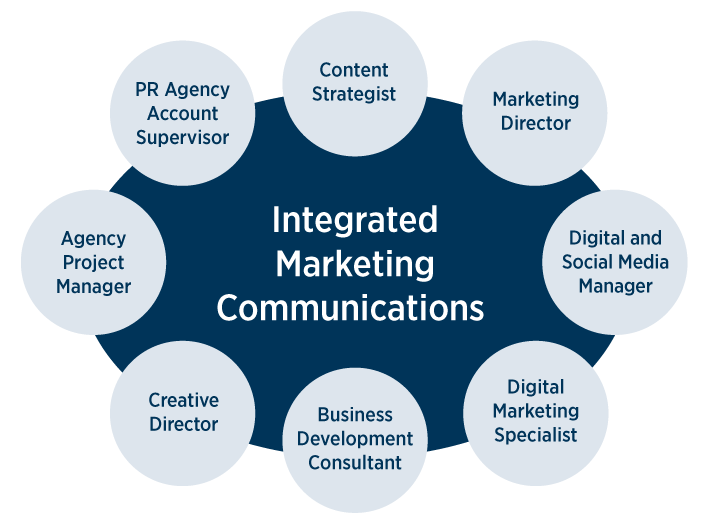It is just a simple concept of making all kinds of communication and messages linked together. This is just to ensure that there is no lack of information. This lack of information can have a negative result on the work. Do you know what is integrated marketing communication?
At the basic level of IMC i.e., Integrated Marketing Communication, all the promoting tools are linked together for smooth communication. You surely must have heard of the marketing mix. Yes, that 4Ps of the marketing mix. This promotion is one of that marketing mixes
To make all the tools work smoothly, all the tools must work together in harmony. This can be advanced when regular communication is integrated into several levels, such as Horizontal, Vertical, Internal, External, and Data integration.
Let’s go through various components of IMC:
1. The Foundation:
In this, a detailed analysis of the product and the target market is required. For the marketers it is essential to understand the nature of the brand, what are its USP (unique selling proposition) and the requirements of the end-user. It is important to have a close eye on your competitor’s behaviors. Every need of the customers is of the utmost importance.
2. The corporate culture:
There must need to be relevant in the product and the producing company. Every organization has its own vision, so while planning marketers need that to keep in mind.
For example, there is an organization whose vision is to train teenagers in the field of their interest. If they start training the middle-aged man they are deviating from the vision.
3. Brand focus:
Every organization is known by the brand they are producing or facilitating. So, it’s important to have plans which are always focused on the brand. Making their brand the center of attention.
4. Consumer experiences:
You must not forget about the consumer and how they feel about the product. Nowadays customers are more attracted to the product which looks good, has good packing, and of course, the product itself needs to be one of the best.
5. Communication tools:
It is a way via which the brand communicates with the customers. The ways can be direct selling, advertising, social media, advertisements, etc.
6. Integration tools:
Selling the product is one part of communication but also getting feedback from the customer is also part communication.
Plans for Integrated marketing communication
It integrates all aspects of the marketing mix to promote the products and services to the customers at the right place and at the right time. It is a proven fact that if you use different IMC tools at the same time it can improve the customer experience of the product.
If done correctly. IMC can improve the visibility of the brand. Whenever a customer goes to the market for shopping, they will be reminded of your brand. The impact of integrated marketing communication increases if the end-user sees the brand simultaneously multiple numbers of times.
A marketer should be well versed in time management. Because doing many things like budgeting, allocating the right resources at the right for the promotion of the product is of utmost importance.
Gathering information about your company and its product and the audience who buy this product is very important for planning.
While planning some points are needed to keep in mind:
- A detailed summary needs to be made on the brand is going to reach its targeted audience.
- Everything about the organization needs to be crystal clear.
- Good knowledge of the product is required.
- Choosing the right market is very important, and hoe you are going to promote it into the market needs to be mentioned clearly.
- Competitors’ analysis is very important. And how the competitors are active in the target market.
- Knowing your brand weakness as well as your strong points can be a good start to promote your brands.
Implementing integrated marketing communication
Integrated marketing communication is a way of promoting the brand through various methods like advertising, social media awareness, direct selling, public relation, etc. It focuses on using all the available ideas together to get the most desired result. Instead of using one integrated tool at a time, it brings all the possible tool under one umbrella and uses any viable option which is used in an effective way.
The success of integrating marketing communication relies totally on understanding the customers, their needs and expectations. Just remember one thing the customer will be loyal towards you only when you outperform their expectations. And to do so you need to be well versed in the marketing mix and need to apply that knowledge in the fields.
Just promoting your product once or twice does not make you gainer. You need to keep doing that. So that whenever they think of buying a product, your brand needs to be the first to come in their mind. This can be done only after promoting the same product several times a day to the same audience. This makes their subconscious mind active and your product makes space in their second mind.
Let’s take Colgate for example, no matter where you are, whenever you think about a toothpaste product the first name that comes into mind is “Colgate”. Why? Because it was their integrated marketing communication skills that have made you think this way. This what an integrated marketing communication does if done correctly.
What are the components of successful integrated marketing communication?
It is essential for organizations to have a well-integrated marketing communication team, who can work hard for the organization. And make the customer satisfied so that the customer can invest in the product. This can only happen if the brand can provide services that can make the customer loyal to the brand.
This can be done only by using the components effectively:
Customer focus
No matter how good your product is, no matter how good is your service is, until and unless you make a customer happy all is worthless.
Do you believe in God?
No, then start believing in the god named “Customers”. If you are a marketer then you need to have faith in this god. Only this god has the power to make your brand, organization what you hope for.
So, if you think ignoring their needs and doing and coming up with the best plan will work for you then you need to go back a little bit and have a fresh start.
Everything about the customer is very important. Their appraisal, as well as their, complains both hold the same value. But for me complain matters the most. That shows where we are lacking and where we need to improve ourselves.
Make sure whatever you are planning customer needs to be at the center of that.
Co operation
Cooperation among the marketing team is important, but it is essential that every member of the organization work as a whole, to promote the product.
Other members who are outside of the department are needed to be allowed to give their thoughts on the matter. This can help in unboxing new ideas, which can really accelerate the promotion.
Database communication
The sharing of information is one of the important aspects of good planning. This helps in formulating the best course of action. Every employee needed to be filled in on every relevant detail that they need to do their job.
Leverage
Analyze every channel on which the promotion is done. Calculate their cost estimation. See that if the ROI on that cost is relevant or not. This helps your brand’s promoting efficiency.
Profitability
At the end of the day, we have to gain revenue. So, making a plan, formulating the strategies are only helpful when they can bring in profits.
So, we have to market in such a way that it really brings in the audience to invest in our brand and stay loyal to the brand. This will help to bring in higher revenue.
Importance of integrated marketing communication
Nobody can deny the fact that integrated marketing communication is an important aspect of the promotion of the brand.
Let’s go much deeper:
It acts as a messenger between the brand and the audience
It recognizes the need of the customers, it gets the data of the competitors, locate an important place for marketing the brand and send this back to the organization for the analysis.
Brand awareness at a low cost
It is a long-term process where you gain audience trust, and convince them to invest in your brand. Integrated marketing communication is the best way to promote your values.
Think like this, if brand A is already communicating with you properly, and delivering its USP on a regular basis. Why would you go for the brand B. you will subconsciously choose brand A
Integrating marketing communication over traditional ways
IMC is taking over traditional ways because it not only focuses on getting new customers but also tries to retain the older on as well. Gaining a new customer does not mean that you forget about the older customer who has already avail of your services. Gaining new customers is very good but losing the older one is not accepted. Because once the trust is broken, it cannot be restored. The customer will never trust you again. So, doing both is of utmost importance.
It reduces the time required for the planning
If not for this IMC, strategizing the plan would take lots of time. It is due to the IMC that the time is reduced to none.
IMC tools
It is essential for organizations to have a well-integrated marketing communication team, who can work hard for the organization. And make the customer satisfied so that the customer can invest in the product. This can only happen if the brand can provide services that can make the customer loyal to the brand.
Let us go through the tools which are used in IMC:
Advertising
It is the best way of promoting the brand. It can reach a huge amount of audience in the shortest time frame. Advertisements on the television, newspaper, radio can reach many audiences in a small frame of time. This also increases the authenticity of the brand. Now it is the marketer’s job to make sure that the right messages are sent to the audience.
Self-promotion
The promotion which the brands do with the promotional code, discounts, attractive offers, etc. brands itself can pay for advertisements to the newspaper, distribute leaflets for the promotions.
Direct selling
There are various tools like mailing, text messages, brochures, which the brands use to promote themselves.
Personal selling
Personal selling here is referred to the selling of the products from their showrooms, via their agents and making sales call.
Public relation activities
Well, have you seen brands presenting themselves in the community meetup, in fairs, in public events? If yes, then you can understand what public relations mean.
It’s all about communication with the public by going in between them. This makes them feel closure to you. This creates a friendship bond with potential customers. Even if they had never thought of investing in your brand, but due to your public appearance. They may think at least once of buying your services.
Managing IMC
It is essential for organizations to have a well-integrated marketing communication team, who can work hard for the organization. And make the customer satisfied so that the customer can invest in the product. This can only happen if the brand can provide services that can make the customer loyal to the brand.
Just making the strategies and implementing those can be said that only half work is done. The rest half is managing and maintain those plans.
There are different modes of communication, so it needs to be managed effectively so that all work in the same synchronization to deliver the same message to all the audience. This can be done with the help of proper managing plans.
The first step is to identify the right audience
Finding the right audience is the best way to make your promotion fruitful. You need to understand who is your audience. what can be done to find the relevant audience for providing services, and who are willing to invest in you. After you find out the answer to these questions, only then you can move on with the second phase of the IMC.
The second step is to think of what to communicate
The kind of message you send to the customer is very crucial for gaining their trust. You need to have a proper crystal-clear message for audiences. This makes your brand much more authentic.
The third step is to plan your message in a way that convinces them
Having clear messages will not do, you need to present them in such a way that the audience likes it and get the meaning of it.
Make sure that your messages are all properly formatted.
The fourth step is to identify the various channel via which you can communicate with them
Choosing the best course of action is very helpful in making a promotional platform. It needs to be efficient that it reaches the right person at the right time.
The fifth step is to allocate the right source at the right time
Investment is needed to be done properly so that ROI gains a profit rather than a loss. So investment needs to be done after analyzing ever aspects of the promotional platforms.
Lastly, it’s important to measure the reach of Integrated marketing communication
You need to monitor constantly that the promotion is reaching the people or not, doing a blind job is just like walking on the edge of the mountain blindfolded.
Conclusion
As a whole, integrated marketing communication lays down a bridge between the organization and the audience. Without the IMC informational gap is created which can lead to malfunctioning of the whole organization.
There are many strategies that can be implemented to overcome any possible crisis faced by the organization.
Each and every detail on integrated marketing communication is given in this article.
Read Also:























